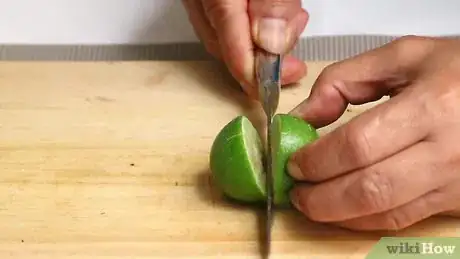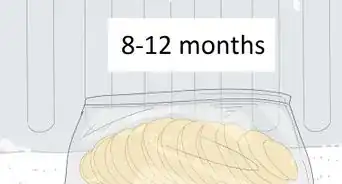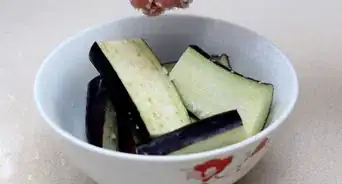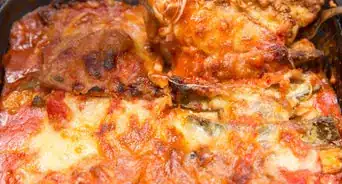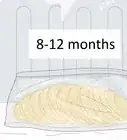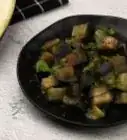This article was co-authored by wikiHow Staff. Our trained team of editors and researchers validate articles for accuracy and comprehensiveness. wikiHow's Content Management Team carefully monitors the work from our editorial staff to ensure that each article is backed by trusted research and meets our high quality standards.
The wikiHow Video Team also followed the article's instructions and verified that they work.
This article has been viewed 25,298 times.
Learn more...
Eggplants come in a variety of shapes and sizes and are easy to find at your local farmer's market or grocery store. There are a number of ways to cut an eggplant depending on whether you are making a classic dish like eggplant parmesan or grilling your eggplant. Once you've thoroughly washed and dried your eggplant you can consider dicing it, chopping it into medallions, or cutting it into long planks. With a few quick cutting tips, you'll be able to properly prepare your delicious eggplant for any dish!
Steps
Dicing an Eggplant
-
1Remove the stem and flower ends of the eggplant. Place your eggplant on a cutting board and use a chef's knife to slice off both ends by cutting widthwise across the eggplant's tips. Hold the eggplant firmly around its center with one hand as you slice with the other.[1]
- Make sure to handle the knife with care to avoid accidental cuts!
- Though most recipes don't require it, you can peel the eggplant if you like.
-
2Slice the eggplant length-wise down the center. Cut the eggplant in half length-wise, holding the eggplant securely on its side. Flip both halves over so that they rest on their flat sides with the skin facing up.[2]
- Placing the flat surface down onto the cutting board will make the eggplant more stable as you continue to cut it into cubes.
- Attempting to cut the eggplant as it rolls on its round side could result in accidentally cutting your fingers!
Advertisement -
3Cut the eggplant halves length-wise into 1⁄2 inch (1.3 cm) thick slices. With the flat side facing down, cut length-wise to create slices. Position your knife so that there is around 1⁄2 inch (1.3 cm) in between each of your slices. Repeat this process to cut the second half of the eggplant into slices.[3]
- Hold the pieces in place with one hand as you cut, keeping them together to retain the original form of the eggplant half. This will make it easier to slice the eggplant into cubes.
-
4Rotate and slice the eggplant width-wise into 1⁄2 inch (1.3 cm) pieces. Holding the loose slices tightly in one hand, rotate the eggplant to cut perpendicular to your original slices. As you cut, the eggplant will fall away into uniform-sized cubes.[4]
- Diced eggplant is great for stir-frys our stews!
Cutting an Eggplant into Medallions
-
1Cut your eggplant width-wise to create round pieces. Use your chef's knife to slice across the eggplant width-wise to create eggplant medallions. Hold the eggplant securely with one hand as you cut, making sure to grip it with the tips of your fingers so that your fingernails face the knife rather than your flesh to protect yourself from accidental cuts. Adjust the thickness of your slices according to your recipe.
- Keep in mind that eggplants lose moisture and shrink when they are cooked. Slice your raw eggplant into pieces that are twice the thickness that you'd like your cooked pieces to be.
- You can peel the eggplant at this stage, if you'd like.
-
2Discard the end pieces. Reserve the stem and flower pieces as you chop the round medallions. Your first and last cuts will remove these parts of the eggplant. Discard the end pieces in the trash or place them in your compost pile.[5]
- The end pieces are tough and are not pleasant to eat so you'll need to remove them before cooking.
-
3Juice a lemon. Place a lemon on your cutting board and slice it in half width-wise. Release the juice into a small bowl by placing the lemon half into the palm of your hand and squeezing. Juice the other lemon half, rotating the lemon slightly in your palm between each squeeze to extract the maximum amount of juice.[6]
- Don't worry about any seeds that fall into the bowl. You can pick them out if you like, but they won't get in the way.
-
4Brush the medallions with lemon juice to prevent them from browning. Use a basting brush to apply a thin layer of lemon juice to each medallion after you have spread them out on your cutting board. Flip the slices and apply the juice to the opposite side to completely cover each slice.[7]
- The lemon juice inhibits the functioning of an enzyme that causes the eggplant's flesh to brown.
- If you don't have a basting brush, you can use a paper towel to apply the lemon juice by dipping it in the bowl and gently wiping the eggplant slices.
- Your eggplant medallions are now ready to be grilled or breaded and fried to make eggplant parmesan!
Slicing an Eggplant into Planks
-
1Remove the flower and stem ends with your knife. Place the eggplant on a cutting board and use a chef's knife to slice off both ends of the eggplant. Hold the eggplant firmly in one hand as you carefully slice each end.
- Removing the ends will get rid of the inedible parts of the eggplant and will also create two flat surfaces to stabilize your eggplant as you chop.
-
2Stand the eggplant on its end and slice length-wise to remove a layer of skin. Hold the eggplant so that it is standing straight up on your cutting board, resting on one of the flat ends you just created. Place your chef's knife at the top of the eggplant and carefully slice straight down to remove a thin layer of skin along one side of the eggplant. Rotate the eggplant 180 degrees and remove another sliver of skin from the opposite side using your knife.
- You do not need to remove all of the skin. Removing the skin on either side of your eggplant before you slice your planks will help to create uniform, even slices. If you'd like to remove all of the skin, you can continue making thin slices on each side of the eggplant until all of the skin is gone.
-
3Slice the eggplant from end to end. Hold the eggplant upright as it continues to rest on one flat tip and carefully push your knife through the eggplant from end to end, moving down in the direction of the cutting board. You will create long, plank-like slices of your eggplant with each slice. Adjust the thickness of your slices according to your recipe, but make sure to remember that your slices need to be twice as thick as you'd like them to be after cooking.
- To avoid accidental cuts, it is best to hold the eggplant upright by pressing down on the top, flat surface rather than holding it around the middle where your fingers could accidentally come in contact with the knife.
- Eggplant planks are great for making dishes that require layering, such as lasagna, or for grilling!
- Consider salting your eggplant planks and pressing them in between paper towels to remove any excess water before cooking them.
Things You'll Need
- Eggplant
- Cutting board
- Chef's knife
- Lemon
- Small bowl
- Paper towels
- Table salt
- Basting brush
References
- ↑ https://www.dummies.com/food-drink/cooking/food-preparation/how-to-dice-an-eggplant/
- ↑ https://www.dummies.com/food-drink/cooking/food-preparation/how-to-dice-an-eggplant/
- ↑ https://www.dummies.com/food-drink/cooking/food-preparation/how-to-dice-an-eggplant/
- ↑ https://www.dummies.com/food-drink/cooking/food-preparation/how-to-dice-an-eggplant/
- ↑ https://www.greatbritishchefs.com/how-to-cook/how-to-dice-an-aubergine
- ↑ https://www.recipetips.com/kitchen-tips/t--1408/how-to-cut-an-eggplant.asp
- ↑ https://www.recipetips.com/kitchen-tips/t--1408/how-to-cut-an-eggplant.asp
